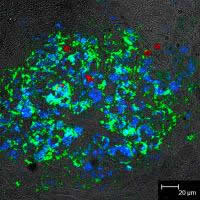Monocyte turnover predicts speed and severity of AIDS and onset of brain disease
Chestnut Hill, Mass. (April 15, 2010) - An increase in the release of monocytes from bone marrow into the bloodstream predicts how rapidly
AIDS develops in monkeys and the magnitude of monocyte turnover correlates with the severity of brain disease in AIDS, Boston College researchers report in the
current edition of the online journal PLoS Pathogens.
 The researchers report the first observation within AIDS of a marker in blood or plasma exclusive to monocytes, which underscores the relationship between innate immune response and the devastating effects of AIDS within the brain. The findings also suggest a potential clinical use of the marker to monitor HIV disease activity, according to Boston College Professor of Biology Kenneth Williams, co-author of the study. The researchers report the first observation within AIDS of a marker in blood or plasma exclusive to monocytes, which underscores the relationship between innate immune response and the devastating effects of AIDS within the brain. The findings also suggest a potential clinical use of the marker to monitor HIV disease activity, according to Boston College Professor of Biology Kenneth Williams, co-author of the study.
The findings advance the understanding of the role that seemingly protective monocytes play in the deadly progression of HIV and AIDS
in the brain, which is an increasingly critical issue. While mortality rates from AIDS have declined thanks to antiretroviral drugs, AIDS-related dementia
remains just as prevalent, particularly as AIDS patients live longer.
White blood cells that play a critical role in the immune system's response to sickness, monocytes migrate from bone marrow to blood
and, in the case of HIV infection, cross the blood-brain barrier, which normally keeps monocyte levels low in the brains of health individuals. Williams and
his lab study monocytes and their more aggressive infection-fighting form, macrophages.
Williams and his co-authors tracked the journey of monocytes by chemically marking the cells to better follow their movement in primates infected with
simian immunodeficiency virus (SIV).
The study found that the monocytes that were labeled in the bone marrow, and trafficked through the blood, were found in the brain within SIV lesions.
All of the cells with the marker were of a particular subtype of monocyte and macrophage known to be important in amplifying immune responses.
Williams' BC colleague and lead author , Researcher Patricia Burdo, said the study showed the magnitude of cells leaving the bone marrow as seen as marked
monocytes predicted which animals would succumb to AIDS rapidly and at death correlated with the severity of SIV brain disease.
Correspondingly, the research also revealed the presence of a protein, soluble CD163, that is only made by monocytes, linked to monocyte expansion
and therefore predicted disease progression. Burdo said marked monocytes were found in brain lesions, offering further evidence that these infection-fighting
blood cells play a role in the damage AIDS does to the brain.
###
CONTACT:
Contact: Ed Hayward
ed.hayward@bc.edu
617-552-4826
Boston College
Source: EurekAlert!
http://www.eurekalert.org/pub_releases/2010-04/bc-mtp041410.php
|